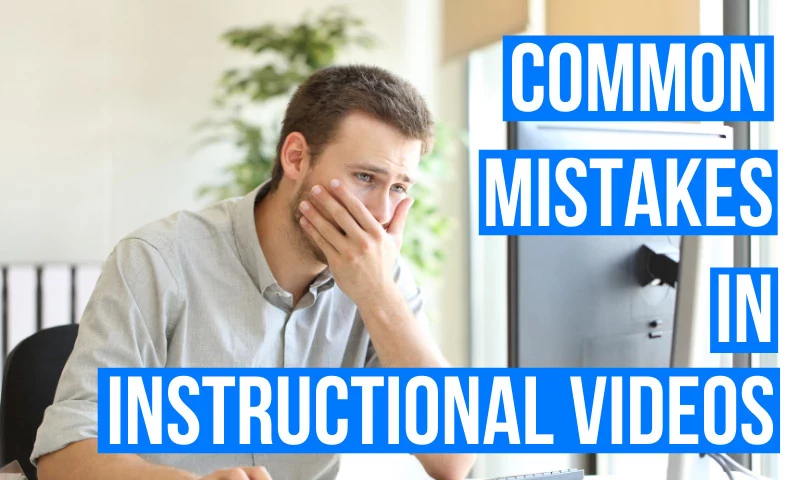The 6 Most Common Mistakes When Making Instructional Videos
Updated on February 24, 2025

Do you know what’s worse than making a poorly edited video? Making a poorly edited instructional video!
If you’re the one meant to be giving good advice and teaching people how to do things and your video doesn’t make sense, you’re going to lose authority, credibility and respect very quickly. Your audience will vanish quicker than ice cream on a hot summers’ day!
So how do you avoid making these fatal mistakes? How do you make the perfect instructional video? As the saying goes, “You have to make mistakes first, so that you can learn from them later”. That’s completely true! One of the best ways to learn how to make great instructional videos is learning what NOT to do.
Today we’re going to go over some of the most common mistakes people commit when making instructional videos, including how to avoid them, and how to fix them.
Let’s jump right in!
1. Not Having a Coherent Script
This might sound like an obvious one, but a lot of people forget or just skip out on this step: always plan out what you want to say!
It doesn’t matter whether it’s in the form of a full-fledged script, or just some detailed bullet points.
If you’re making an educational video, you don’t want to be stuttering all the way through. When you’re constantly saying “erm” or “ah”, your video comes off as lazy and not well thought out.
Small bits of improvisation can be done well, but make sure you know when the appropriate time is to improvise, and how to stop yourself from going on a tangent that has no relevance to what you’re trying to teach. Tangents show no clear train-of-thought and will disrupt the flow of your video.
2. Bad Audio Quality
Audio quality is one aspect of video production that beginner/amateur videographers, editors and content creators often overlook. It should, however, be very obvious that the best way of making sure that what you’re trying to get across is abundantly clear, is to make your voice, well…clear!
Having your microphone too far way is one of more common mistakes people make when recording their video. The mic might not pick up softer tones, especially if you have a tendency to gesticulate and move around when talking.
However, even if having to correct your sound in post-production is not ideal. audio levels can thankfully be adjusted while editing, and it’s quite easy to do so, particularly with Flixier, so if you’ve only discovered your audio is too quiet after the recording stage, this can still be fixed.
To learn how to increase the gain of your recording in Flixier, check out our video tutorial below:
Something that can’t be fixed in the editing process is the quality of the microphone itself. So many beginners simply rely on their Airpods or use the built-in microphone on their laptop/desktop, but don’t fall into that same trap. Good quality, inexpensive microphones can be found online for cheap, and they are guaranteed to be 10 times better than any built-in microphone.
Speaking of external microphones, if you do decide to get one, please make sure that you’re speaking into the right side of it. Some microphones are top-address, meaning you talk into the end of the microphone and some are side-addressed, meaning you need to keep the side of the microphone turned towards your mouth.
If you’re not sure what kind of microphone you have, look it up online or check the box if you still have it. Don’t spend $100 on a microphone only to have it sound as bad as a mobile phone just because you didn’t read the instructions!
For more information on how to improve your audio quality as well as some solid microphone suggestions, feel free to check out these two blog posts we wrote on the topic:
- 7 tips that will make your microphone sound better when recording
- How to make your voice recordings sound better in Audacity
The first one is chock full of positioning advice and other things you can do to improve your sound before you even start recording, while the first one focuses on post-production to add that extra crispiness and professional touch.
3. Bad Video Quality
Just like audio, capturing good quality video can be tricky for beginners. Even if your tutorial only features screencasts/screen recordings, a lot of screen recording software is hard to navigate. All the settings can be confusing for a beginner (and messing with them tends to result in blurry/compressed videos), not to mention that finding where your videos have been saved can be quite a pain.
Flixier can help you solve all of those problems. For example, we offer easy screen and webcam recording with just a couple of clicks and our export menu is very straightforward; you don’t have to worry about choosing codecs and formats and potentially ruining the quality of your final video. Your video will look as crisp as it possibly can be!
If you want to learn more about how to capture video with Flixier, check out our video tutorial on the subject below:
4. Using Too Much Jargon
The word jargon gets thrown around a lot when it comes to tutorials and instructional videos; what it means is subject-specific language. This language is usually unfamiliar to those who are not well versed in the subject, and it can make your videos confusing for them.
If the purpose of your video is to educate your audience on a subject that they might not know anything about, then don’t use words that only someone who knows the subject would understand. It’s as simple as that!
Of course, the odd word here or there isn’t going to hurt, especially if there’s isn’t any simpler way to express what you’re talking about. Just make sure to explain the word to your audience as best you can and don’t go overboard!
5. Not Annotating Clips
One of the key steps when editing any video, is adding in supplementary visuals layered over the top of your raw footage. These can be text annotations, motion graphics to more easily display what you’re talking about, etc.
These annotations are particularly useful in instructional videos. As I just mentioned, they help you get your point across more easily, especially if you’re dealing with complex topics such as computer coding, mathematics, sculpting and art, etc.
Diagrams and additional information can help those who may need a little more explanation but, for obvious reasons, can’t ask questions in real time.
And if you’re not sure on how to add annotations to your videos, then you’re in luck, since Flixier already has an in-depth, easy-to-follow guide on how to add motion graphics and annotations to your instructional or educational videos!
6. Making Your Videos Too Long
This is by far the worst, and most common, mistake made by amateur video makers. Instructional and educational videos should be concise and to the point.
f your video is precise and to the point, you shouldn’t need to fill 25 minutes’ worth of content!
Unless you’re covering an incredibly complex and difficult topic then your videos should be no longer than 10 minutes, and that’s on the high end of the scale; you should really be aiming for somewhere between 5-8 minutes.
If your video is 15, 20, or 25 minutes and you don’t think there’s any way of cutting that down, then consider splitting that one huge video up into smaller, bite-size videos.
This will be much easier for the viewer to digest, and it also makes the viewer feel as if they are making constant progress when they move from one short clip to the next; and all through the power of editing!
Closing Words
Well, there were a few of the most common mistakes made when editing instructional videos. We hope what you learned today will help you make better instructional videos! If you want to edit better videos yourself, you can start using flixier to create instructional videos now.
If you want more guides and video tutorials, feel free to check out the rest of our blog and subscribe to our YouTube channel.
Dan is passionate about all things tech. He’s always curious about how things work and enjoys writing in-depth guides to help people on their content creation journey.



